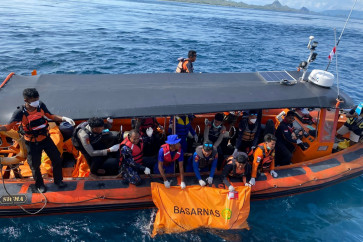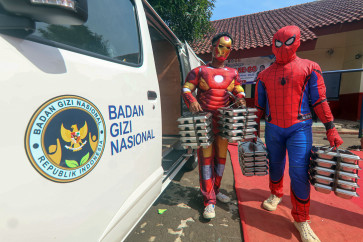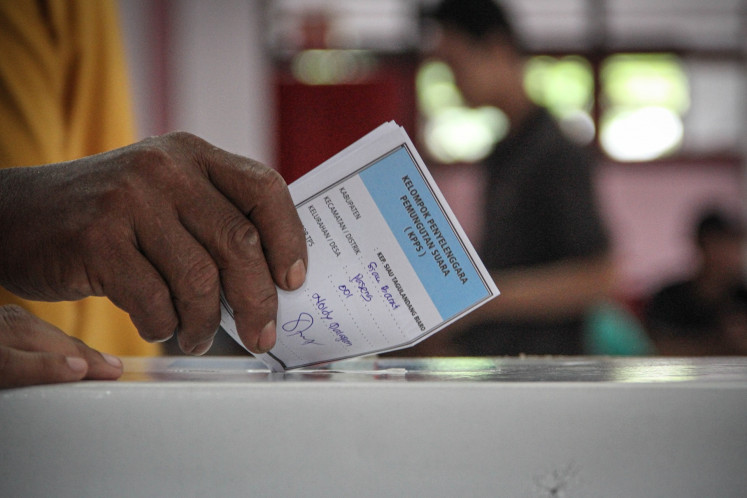Popular Reads
Top Results
Can't find what you're looking for?
View all search resultsPopular Reads
Top Results
Can't find what you're looking for?
View all search resultsFrom fisherfolk to orangutans, many bear brunt of smog
Up in smoke: The Moderate Resolution Imaging Spectroradiometer (MODIS) on NASA’s Aqua satellite captured this image of Borneo on Sunday
Change text size
Gift Premium Articles
to Anyone
U
p in smoke: The Moderate Resolution Imaging Spectroradiometer (MODIS) on NASA’s Aqua satellite captured this image of Borneo on Sunday. Smoke hovered over the island and has triggered air quality alerts and health warnings in Indonesia and neighboring countries. Many fires are burning in Kalimantan where there are extensive peat deposits, which are made up of decayed wetland vegetation.(Courtesy of NASA)
Smog caused by forest and land fires has spread to wider areas, disrupting people’s activities and even affecting the health of orangutans as the government scrambles with its dousing efforts.
Fisherfolk in Pandan district, Central Tapanuli regency, North Sumatra, have not been able to go fishing in the past week as smog from fires in Riau has blanketed the area, affecting visibility in the region.
Fisherman Ucok Pasaribu said the smog had disrupted fisherfolk’s activities as they feared losing their way amid the limited visibility.
“We use traditional equipment, so there are no [modern] navigation devices on our boats. Fisherfolk could lose their way and even reach the Indian Ocean without navigation tools given the current state of the smog,” Ucok told The Jakarta Post on Wednesday, adding that many had lost their way due to the limited visibility.
As a result, the fisherfolk can only catch fish on the seashore, which means their hauls are much smaller as they cannot risk going out to sea.
A number of regions in North Sumatra have been blanketed by smog coming from Riau due to the southeasterly wind disrupting the activities of people in Padang Sidempuan, South Tapanuli, Padang Lawas, Toba Samosir and Simalungun, among other affected regencies.
Officials in the region have advised people to limit outdoor activities and called on those suffering from smog-related illnesses to seek treatment at nearby health centers.
Calls, meanwhile, have emerged for the establishment of safe houses in Jambi as victims, including children, have reportedly sought treatment through their own means amid the persisting smog.
Fikri, a 5-year-old toddler from Muarosabak, East Tanjungjabung regency, had to be hospitalized for five days after reportedly suffering from eye irritation due to the smog.
“According to the doctor, Fikri’s right eye suffered from irritation caused by the smog. The eye had to be bandaged and he had to undergo intensive treatment,” his mother Susilawati said, adding that the family had covered Fikri’s medical bills on their own.
Meanwhile, Kiara, 2, from Dendan, East Tanjungjabung, was forced to undergo outpatient treatment after she was hospitalized between Sept. 8 and 10 due to asthma and coughing as her parents could not risk being charged with high rates for the treatment.
“We decided to just let K undergo outpatient treatment,” said her mother, Rahmah.
All yellow: A map shows organic carbon data from Tuesday, from the GEOS forward processing model, which assimilates information from satellite, aircraft and ground-based observing systems.(Courtesy of NASA)The establishment of the safe houses was deemed necessary by environmental activists as vulnerable groups were prone to being affected by the smog, including pregnant women.
“The establishment of safe houses is very urgent, because so far, smog victims have been seeking treatment at the hospital on their own,” said Feri Irawan, the chairman of Green Association, a network of the Indonesian Forum for the Environment (Walhi) in Jambi.
He added that the public seemed not to have been informed about countermeasures with regard to the impacts of the smog, expressing hope that the establishment of safe houses could ensure good coordination among concerned parties in taking responsibility for the victims.
NGO Beranda Perempuan spokeswoman Zubaidah urged the government to take serious care of the victims, who have fallen ill because of others’ doing.
“They are the victims of smog. Their residences have been blanketed by smog coming from burned peatland areas,” she said.
Smog has not only affected humans, as 37 orangutans in the Nyaru Menteng Orangutan Rehabilitation Center, located near Central Kalimantan’s capital of Palangkaraya, have reportedly suffered from acute respiratory infection (ISPA) from the pollution that continues to blanket the region.
The rehabilitation center currently houses 355 orangutans cared for by the Borneo Orangutan Survival Foundation (BOSF).
“Thank God they’re still in the early stage of infection. The medical team has provided them with multivitamins and antibiotics; they’ve also been given medicine through nebulizers, especially those who seem to have a more severe infection,” BOSF chief executive officer Jamartin Sihite said on Tuesday.
Thin smog also blanketed another orangutan rehabilitation center managed by the BOSF in Samboja Lestari, some 50 kilometers away from Balikpapan, East Kalimantan. The center currently houses 130 orangutans.
Technicians at the center were forced to spray water into orangutans’ cages and their surroundings at least three times a day to clear the air and maintain a mild temperature amid the persisting smog.
BOSF spokeswoman Paulina Laurensia said that in the meantime, the foundation had to limit any outdoor activities involving young orangutans.
This includes the Forest School, which aims to equip orangutans with skills to survive in the forests after many of them could not develop the ability due to previous adoptions or loss of habitat.
“To improve their immune systems, we also feed them all with milk and multivitamins. [...] Thank God so far no orangutans have suffered from ISPA,” Paulina said.
— Ardila Syakriah in Jakarta contributed to the story

![Up in smoke: The Moderate Resolution Imaging Spectroradiometer (MODIS) on NASA’s Aqua satellite captured this image of Borneo on Sunday. Smoke hovered over the island and has triggered air quality alerts and health warnings in Indonesia and neighboring countries. Many fires are burning in Kalimantan where there are extensive peat deposits, which are made up of decayed wetland vegetation.(Courtesy of NASA)" width="780" height="522" border="0">Up in smoke: The Moderate Resolution Imaging Spectroradiometer (MODIS) on NASA’s Aqua satellite captured this image of Borneo on Sunday. Smoke hovered over the island and has triggered air quality alerts and health warnings in Indonesia and neighboring countries. Many fires are burning in Kalimantan where there are extensive peat deposits, which are made up of decayed wetland vegetation.(Courtesy of NASA)</p><p>Smog caused by forest and land fires has spread to wider areas, disrupting people’s activities and even affecting the health of orangutans as the government scrambles with its dousing efforts.</p><p>Fisherfolk in Pandan district, Central Tapanuli regency, North Sumatra, have not been able to go fishing in the past week as smog from fires in Riau has blanketed the area, affecting visibility in the region.</p><p>Fisherman Ucok Pasaribu said the smog had disrupted fisherfolk’s activities as they feared losing their way amid the limited visibility.</p><p>“We use traditional equipment, so there are no [modern] navigation devices on our boats. Fisherfolk could lose their way and even reach the Indian Ocean without navigation tools given the current state of the smog,” Ucok told <em>The Jakarta Post</em> on Wednesday, adding that many had lost their way due to the limited visibility.</p><p>As a result, the fisherfolk can only catch fish on the seashore, which means their hauls are much smaller as they cannot risk going out to sea.</p><p>A number of regions in North Sumatra have been blanketed by smog coming from Riau due to the southeasterly wind disrupting the activities of people in Padang Sidempuan, South Tapanuli, Padang Lawas, Toba Samosir and Simalungun, among other affected regencies.</p><p>Officials in the region have advised people to limit outdoor activities and called on those suffering from smog-related illnesses to seek treatment at nearby health centers.</p><p>Calls, meanwhile, have emerged for the establishment of safe houses in Jambi as victims, including children, have reportedly sought treatment through their own means amid the persisting smog.</p><p>Fikri, a 5-year-old toddler from Muarosabak, East Tanjungjabung regency, had to be hospitalized for five days after reportedly suffering from eye irritation due to the smog.</p><p>“According to the doctor, Fikri’s right eye suffered from irritation caused by the smog. The eye had to be bandaged and he had to undergo intensive treatment,” his mother Susilawati said, adding that the family had covered Fikri’s medical bills on their own. </p><p>Meanwhile, Kiara, 2, from Dendan, East Tanjungjabung, was forced to undergo outpatient treatment after she was hospitalized between Sept. 8 and 10 due to asthma and coughing as her parents could not risk being charged with high rates for the treatment.</p><p>“We decided to just let K undergo outpatient treatment,” said her mother, Rahmah.</p><p><img class="image image-img_assist_custom-780x593 " src="http://202.158.21.182/files/images2/01 All yellow.img_assist_custom-780x593.jpg" alt="All yellow: A map shows organic carbon data from Tuesday, from the GEOS forward processing model, which assimilates information from satellite, aircraft and ground-based observing systems.(Courtesy of NASA)" title="All yellow: A map shows organic carbon data from Tuesday, from the GEOS forward processing model, which assimilates information from satellite, aircraft and ground-based observing systems.(Courtesy of NASA)](https://www.thejakartapost.com/files/images2/01 UP in SMoke.img_assist_custom-780x523.jpg)









